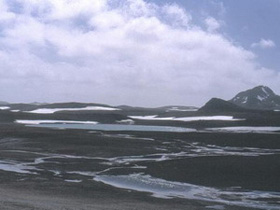Antarctic virus has a high level of genetic diversity
A group of Spanish biologists has just published a discovery in Antarctica that viruses with very high levels of genetic diversity, contrary to the long-standing view of the scientific community that regions with carved climatic conditions harshness is often poor in biology.
In the biology study in the Limnopolar Lake area on Livingston Island, Spanish scientists mentioned 90,000 viral gene sequences. This is the largest number of 'families' of viruses ever found in a microbial ecological community (known as metagenome) under water.

Limnopolar lake area.(Photo: Internet).
From these data, the team estimated that in Limnopolar lake there are about 10,000 species of viruses. In addition, scientists also discovered a large number of viruses with a high-level structure, with variable nuclei.
Biologist Antonio Quesada, of the Autonomous University of Madrid, commented that both the number and diversity of viruses found were surprising. Quesada said it was the first work to describe the evolution of virus species before and after the thawing period. The researchers also discovered the existence of extremely small viruses and some unknown families.
As for biologist Antonio Alcami, of the Spanish Council for Advanced Scientific Research (CSIC), this four-year study is the first step in understanding the role of viruses in systems. Ecology with very harsh climatic conditions.
He said that the most important problem researchers have discovered is why with just 5,000-6,000 years of age, this ecosystem has such a large level of virus skin.
The work is part of the Limnopolar project, which began in 2001, to analyze the possibility of using freshwater ecosystems in polar regions as global climate change sensors. .
- Ice mountains 'disrupt' ecological diversity in the Antarctic seabed
- Chimp is more genetic than human
- New discovery of level 3 negative breast cancer
- High education level is hereditary?
- Antarctic ice may have begun to melt due to El Nino from the 1940s
- Decoding the gene of the big cat family line
- Antarctic ice will melt quickly in the next decades
- Super high resolution of the new map of the icy continent
- Discover genetic clues about Ebola outbreak
- Detecting sex reduces genetic changes
- The study of fine-haired mammoth gene changes the theory of evolution
- A 300km ice block suddenly melted in the Antarctic Peninsula
 Why do potatoes have eyes?
Why do potatoes have eyes? 'Tragedy' the world's largest carnivorous life: Death becomes ... public toilet
'Tragedy' the world's largest carnivorous life: Death becomes ... public toilet Tomatoes were once considered 'poisonous' for 200 years
Tomatoes were once considered 'poisonous' for 200 years Detecting microscopic parasites on human face
Detecting microscopic parasites on human face